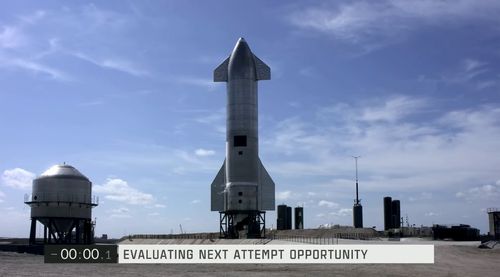SpaceX aborts Mars prototype rocket test launch with 0.1 seconds on the clock

Another SpaceX rocket prototype was fueled and ready for a test flight Wednesday, but in the final moments before liftoff, the vehicle’s engines sputtered off and the company announced it had aborted the flight.
The company will recycle the rocket’s fuel and attempt liftoff again around 4 pm CT, according to SpaceX engineer John Insprucker on the company’s webcast of the attempted launch.
SpaceX CEO Elon Musk said in a tweet that the abort was triggered by pre-set standards around the rocket’s thrust, which Musk described as “slightly conservative. He added that the company would increase the rocket’s thrust limit, giving the rocket more wiggle room for getting a go-ahead for liftoff, and attempt to launch again later Wednesday.
SpaceX’s SN10, an early prototype of the company’s Starship Mars rocket, was expected to soar about six miles (10 km) above the coastal landscape before conducting some mid-air acrobatics and swooping down for a landing back at SpaceX’s South Texas facilities. SpaceX has attempted such a test flight twice before, with both ended in a crash landing.
Insprucker said that the primary goal of the test was to gather data on how the vehicle’s flaps would control the Starship prototype as it plummets back to the Earth.
Musk first explained Starship’s intended landing method during a September 2019 media event. He billed it as a unique maneuver that would see the rocket dive back through the air with its belly pointed toward the Earth as its four fins shift slightly to keep it steady. It’s a maneuver Musk said is intended to mimic how a skydiver would fall through the air, rather than the straight vertical descent to Earth that SpaceX’s Falcon 9 rockets employ when they’re coming in for landings.
Perfecting the belly-flop landing maneuver is essential to “enable a fully reusable transportation system designed to carry both crew and cargo on long-duration, interplanetary flights and help humanity return to the Moon, and travel to Mars and beyond,” according to the company’s website.
Though prior attempts have met explosive endings, SpaceX is known to embrace fiery mishaps during the rocket development process. The company maintains that such accidents are the quickest and most efficient way of gathering data, an approach that sets the company apart from its close partner NASA, which prefers slow, methodical testing over dramatic flare ups.
SpaceX intends to use Starship for a variety of purposes, including shuttling paying customers between cities at breakneck speeds, potentially aiding NASA’s moon landing efforts, and, eventually, launching cargo and human missions to Mars.
Starship is still in the early stages of development. A full-scale prototype has yet to be constructed. Nor has SpaceX begun publicly testing Super Heavy, a gargantuan rocket booster that will be needed to propel the Starship to Earth’s orbit or beyond.
Musk said during a recent interview with podcast host Joe Rogan that he expects Starship will be conducting regular flights by 2023, and he hopes the vehicle will reach orbit by the end of this year. It’s not clear if SpaceX will hit that deadline. The aerospace industry, and Musk in particular, is notorious for announcing projects that take far longer — and tally much higher expenses — than first anticipated.